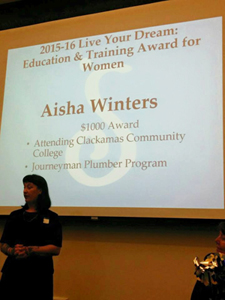Archive for April 2016
Making Construction Work for Women – Guest Blog by Megan Wild

Evaluating the Growth of Women’s Roles in Construction
As the Great Recession becomes a distant memory, the housing and construction markets are poised to make a big comeback. The overall construction industry is projected to grow by just over three percent by 2019, and residential construction is expected to do even better as people get back into the business of investing in homes. Population growth will help as Millennials begin to raise their own families and seek a place to set down more permanent roots during the general economic recovery.
While this projection is great news on the surface, such growth begs an obvious question: Will the construction industry be able to keep up?
The Construction Industry Struggles to Attract New Workers
Despite the positive outlook for jobs in the construction industry, the industry needs to do more to attract and train new workers who will stay in these jobs.
With the decline of trade schools and vocational education resulting from nearly two decades of focus on standardized testing and college-readiness programs, most students lack the skills they need to work even entry-level construction jobs without employers investing in on-the-job training for them. The Department of Labor recommends much stronger outreach and recruitment programs to make these jobs more attractive to potential workers.
Women in Construction: An Untapped Resource
According to the National Women’s Law Center, women make up only about three percent of the construction industry’s workforce — a statistic that has remained relatively stable despite the fact that more women are entering the workforce than ever before.
A recent McKinsey study reports that 80 percent of Millennial women look at a potential employer’s record on promoting diversity when choosing among job offers. This makes it all the more challenging for construction companies to entice young female employees, as they aren’t very diverse workplace to begin with. It’s a potentially vicious cycle.

Additionally, women face structural obstacles to attaining career success and promotions in the construction field. Because there are so few of them, they lack female role models and mentors in the industry, so they are often less able than their male counterparts to network and grease the social wheels to climb the ladder of leadership. Their skills may also be undervalued by predominantly male leadership as well.
Finally, many women who are interested in construction and careers in the trade industries face a set of cultural assumptions about their abilities and desires. They may be encouraged to follow more traditionally “feminine” service paths in the beauty or healthcare service industries, when in reality they want to use their hands to build things.
For example, Queens construction worker Herlema Owens explains that she knew in a flash she wanted to do construction: “It was exciting and on that first day, I knew this was exactly what I wanted to do for the rest of my life.”
Luckily for Owens, she was able to follow her dream through sheer strength of spirit, but she realized that other women might not be so luckily. To help educate women about their options in the construction industry, she founded the Association of Women Construction Workers of America, a nonprofit organization that runs classes and supports women in the trades.
Organizations like Owens’ are crucial components in attracting women into construction jobs. In addition, large construction firms will have to take the lead to attract women and change their workplace culture to make sure women feel both safe and valued on the job.
Companies such as Ring Power who sell new and used construction equipment make it clear on their website that they are willing to hire anyone who is capable to complete the job, gender is not an obstruction to a job. More companies like this are needed to promote the advancement of women in construction trades.
To this end, equal training and opportunities for advancement must be offered, and it’s important for construction firms to enact and enforce robust anti-discrimination and anti-harassment policies that all employees must follow. When workplace culture evolves to value women, more women will stick with the field.
Construction companies will need to take the lead on attracting women into the field if they hope to compete during the coming boom years. After all, no company can expand — let alone survive — if it can’t attract enough workers to get the jobs done. Women are a critical, untapped resource, and smart companies will be on the cutting edge of getting women into the construction industry in large numbers.
……………………………………………………………………..
Megan Wild is a construction writer who specializes in residential homes. She likes writing about construction, real estate, and other industries on her blog, Your Wild Home.
Aisha Winters Awarded the Live Your Dream Scholarship!
After Aish a Winters graduated from OTI’s Trades and Apprenticeship Career Class (TACC) in the summer of 2015, she was determined to start into an official apprenticeship. She was out of work for a few months, but had some money in savings to help make ends meet while she pursued her goal of apprenticeship.
a Winters graduated from OTI’s Trades and Apprenticeship Career Class (TACC) in the summer of 2015, she was determined to start into an official apprenticeship. She was out of work for a few months, but had some money in savings to help make ends meet while she pursued her goal of apprenticeship.
OTI Career Counselor, April Robbins, connected Aisha to Marianne Carley at the Area 1 JATC in Clackamas – an open shop school offering apprenticeship training in plumbing, sign making, painting, and the electrical trade. Marianne was happy to meet Aisha and connected her for a for job shadowing opportunity at Mr. Rooter. During her very first ride along, Aisha knew she liked the opportunity, and was thrilled when they asked her if she was interested in getting hiring on! It was only a couple of weeks later and she was accepted into the plumber’s apprenticeship!
As excited as Aisha was for the opportunity, she was also feeling nervous about the financial obligation. She didn’t realize in the beginning that she would be responsible for paying her own tuition. She had used most of her savings over the summer, and she also needed money to pay for daycare for her child.
Compounding the situation, Aisha had been on the Oregon health plan so that her daughters would have health insurance, but she cancelled the insurance after she was hired by Mr. Rooter, only to learn that there was a trial period before she would be eligible to receive her new health insurance benefits. Like many Oregon renters, her rent went up. And further, she incurred some transportation issues when her truck started having some mechanical issues. It was a huge financial outlay for Aisha when she was just in the beginning of her new career. She was scared for a while, but was able to borrow some money from family to get her through this stressful time.
Not too long after getting over these initial hurdles, a girlfriend contacted her through Facebook to let her know about the Soroptimist “Live Your Dream Awards”. Aisha met all 15 qualifications to apply, but she was a bit intimidated by the process.
She didn’t let her fear stop her though, and wrote amazing letter to apply for the $1,000 grant. Three people wrote letters of reference for her, including the owner of Mr. Rooter
A short time later, foundation member Pam Banning with Soroptimist International of Lake Oswego/West Linn called her to let her know she would be awarded with a $1,000 check on March 8, 2016 which was also International Women’s Day.
Because Aisha was chosen as the first place winner, her application will go to the regional level where she will be considered for a $5,000 scholarship. If she were to win the regional competition, then she has the potential to win a national prize of $10,000.
All of us at OTI are so incredibly proud of Aisha for all she has accomplished and will be crossing our fingers that she goes on to win these additional scholarship prizes.
Way to go, Aisha!